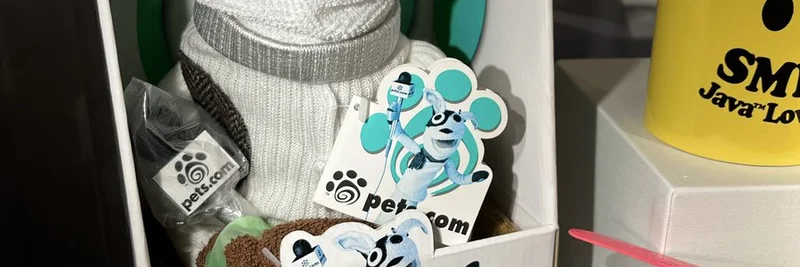Marc Andreessen, the legendary venture capitalist behind a16z, dropped a thought-provoking tweet that's got the tech and crypto worlds buzzing. In it, he calls out Pets.com – often misremembered as Petsmart in casual convos – as the ultimate "slur" of the Dot-Com era. You know, that time in the late '90s when everyone thought the internet was a bubble ready to pop. Andreessen points out how Pets.com burned through about $182 million in investor cash before crashing and burning. But fast-forward to today, and the US online pet goods market alone is raking in around $38 billion a year, with a total market cap hitting $70 billion when you factor in giants like Amazon and Walmart. His emoji says it all: 👀.
Here's the tweet in full: "https://www.petsmart.com/ is the go-to slur of the Dot Com era. Let's see: https://www.petsmart.com/ burned ~$182M total investor capital before going bust. Today, just US online pet goods sales = ~$38B/year; ~$70B total market cap including portions of Amazon & Walmart. Hmm. 👀" You can check it out here.
(Note: It looks like a typo in the URL – it's referencing the infamous Pets.com, the online pet supply retailer with the iconic sock puppet mascot that became a symbol of Dot-Com excess.)
The Dot-Com Echo in Today's Crypto Scene
This isn't just nostalgia; it's a masterclass in timing and vision. Back in 2000, Pets.com was laughed off as a ridiculous idea – selling dog food online? Who'd pay for shipping on heavy bags of kibble when you could grab it at the local store? The company went public with fanfare, hit the Super Bowl with ads, but couldn't turn a profit amid sky-high logistics costs and low internet adoption. Boom, bust.
But Andreessen's point? They weren't wrong; they were early. Today, companies like Chewy dominate the space, proving the model works when the infrastructure catches up – better logistics, widespread broadband, and mobile shopping. As one reply from @KyleTibbitts puts it: "Early is the same as being wrong I guess." Ouch, but true in the short term.
This photo from a reply by Michael P. Gibson shows the Pets.com puppet on display at the Computer History Museum – a relic of innovation gone "wrong" too soon.
Drawing Parallels to Meme Tokens
Now, let's bridge this to meme tokens, the wild west of crypto that's our bread and butter here at Meme Insider. Meme coins like Dogecoin, Shiba Inu, or the latest frog-themed sensations are often dismissed as jokes – pure speculation with no "real" utility. Critics call them the Pets.com of blockchain: overhyped, underdelivering, and destined to crash.
But what if, like Pets.com, they're just ahead of the curve? Meme tokens thrive on community, virality, and cultural relevance – elements that echo the early internet's chaotic energy. In the Dot-Com days, skeptics mocked e-commerce as a fad. Today, in web3, detractors say the same about decentralized finance powered by memes.
Consider this: Meme tokens are democratizing crypto adoption. They pull in retail investors with low barriers, fun narratives, and massive upside potential. Sure, many flop, but survivors like DOGE have market caps in the billions and real-world integrations (think Tesla payments). As @gibfather replied to Andreessen: "is being too early the same as being wrong?" In crypto, where tech evolves at warp speed, the answer might be no.
Look at the numbers Andreessen highlights – that $38B online pet market didn't exist in 2000. Similarly, the total meme coin market cap has exploded to over $50B in recent years, per CoinMarketCap data. If history rhymes, today's meme "busts" could pave the way for tomorrow's trillion-dollar ecosystems in decentralized social, gaming, or even AI-driven communities.
Key Lessons for Blockchain Practitioners
As someone who's covered crypto from the trenches, here's what we can take away:
Timing is Everything (But Patience Wins): Pets.com failed because broadband penetration was under 5% in the US back then. Meme tokens might seem frivolous now, but with growing blockchain adoption – think Ethereum's layer-2 scaling or Solana's speed – they're positioning for mass appeal.
Community Over Hype: The Dot-Com crash weeded out weak players, leaving room for Amazon and Google. In memes, strong communities (like Pepe's cult following) survive pumps and dumps, evolving into DAOs or utility tokens.
Risk and Reward: Investors poured $182M into Pets.com and lost it all short-term, but the idea birthed a huge industry. Meme token holders: DYOR (do your own research), diversify, and think long-term. As @drawkkwast noted: "The difference between success and failure is simply what part of the timeline you happen to be focusing on."
Tommy Campbell's reply memorializes other Dot-Com casualties – a reminder that failure often precedes breakthroughs.
Wrapping Up: Don't Dismiss the Memes
Andreessen's tweet is a wake-up call: What we mock today could define tomorrow. In the meme token space, we're seeing echoes of that Dot-Com spirit – bold, risky, and potentially revolutionary. Whether you're a dev building on-chain or a trader hunting alphas, keep an eye on these "slurs" of crypto. They might just be the next Chewy.
For more insights on meme tokens and blockchain trends, stick around Meme Insider. What's your take on this analogy? Drop a comment or hit us up on X.


